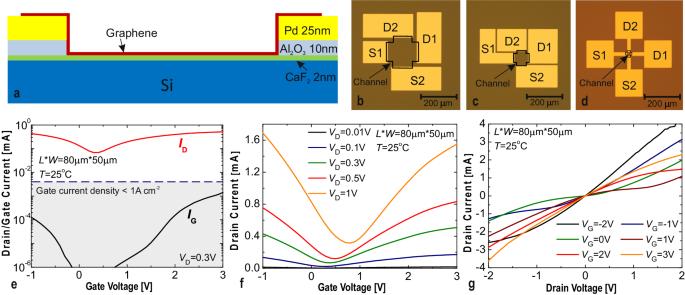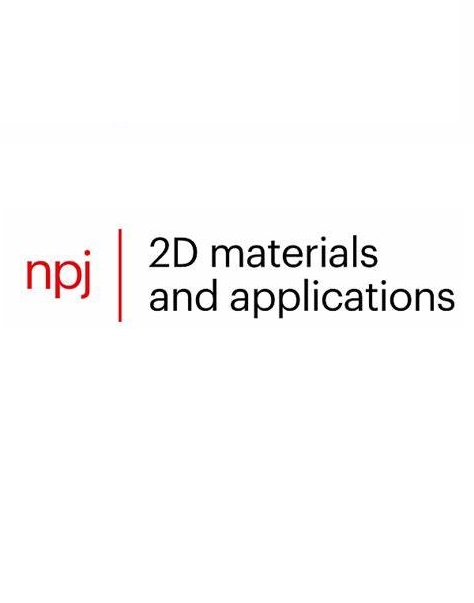具有薄外延 CaF2 绝缘层的石墨烯场效应晶体管的变异性和高温可靠性
IF 8.8
2区 材料科学
Q1 MATERIALS SCIENCE, MULTIDISCIPLINARY
引用次数: 0
摘要
石墨烯是一种应用前景广阔的材料,可用作石墨烯场效应晶体管(GFET)的通道,该器件可用作光电子、高频器件和传感器的构件。然而,这些器件需要栅极绝缘体,理想情况下,栅极绝缘体应与石墨烯形成原子平界面,同时含有小密度的陷阱,以保持器件的高稳定性。然而,以前使用的非晶氧化物(如 SiO2 和 Al2O3)通常在界面上存在氧化物悬空键、高表面粗糙度和大量边界氧化物陷阱。为了应对这些挑战,我们在这里使用 2 nm 厚的外延 CaF2 作为 GFET 的栅极绝缘体。通过分析分两批制造的约 200 个器件的器件间差异,我们发现其中数十个器件显示出相似的栅极转移特性。我们对高达 175oC 的磁滞进行统计分析后发现,虽然某些器件中可能存在对环境敏感的逆时针磁滞,但主要机制是 CaF2 中边界缺陷的热激活电荷捕获,这导致了传统的顺时针磁滞。我们的研究表明,使用 CaF2 的 GFET 的磁滞和偏置-温度不稳定性与使用 SiO2 和 Al2O3 的类似器件相当。特别是,在电场高达 15 MV cm-1 和扫描时间在千秒范围内、等效氧化物厚度 (EOT) 约为 1 nm 时,我们实现了低于 0.01 V 的小滞后。因此,我们的研究结果表明,结晶 CaF2 是一种很有前途的高稳定 GFET 绝缘体。本文章由计算机程序翻译,如有差异,请以英文原文为准。

Variability and high temperature reliability of graphene field-effect transistors with thin epitaxial CaF2 insulators
Graphene is a promising material for applications as a channel in graphene field-effect transistors (GFETs) which may be used as a building block for optoelectronics, high-frequency devices and sensors. However, these devices require gate insulators which ideally should form atomically flat interfaces with graphene and at the same time contain small densities of traps to maintain high device stability. Previously used amorphous oxides, such as SiO2 and Al2O3, however, typically suffer from oxide dangling bonds at the interface, high surface roughness and numerous border oxide traps. In order to address these challenges, here we use 2 nm thick epitaxial CaF2 as a gate insulator in GFETs. By analyzing device-to-device variability for about 200 devices fabricated in two batches, we find that tens of them show similar gate transfer characteristics. Our statistical analysis of the hysteresis up to 175oC has revealed that while an ambient-sensitive counterclockwise hysteresis can be present in some devices, the dominant mechanism is thermally activated charge trapping by border defects in CaF2 which results in the conventional clockwise hysteresis. We demonstrate that both the hysteresis and bias-temperature instabilities in our GFETs with CaF2 are comparable to similar devices with SiO2 and Al2O3. In particular, we achieve a small hysteresis below 0.01 V for equivalent oxide thickness (EOT) of about 1 nm at the electric fields up to 15 MV cm−1 and sweep times in the kilosecond range. Thus, our results demonstrate that crystalline CaF2 is a promising insulator for highly-stable GFETs.
求助全文
通过发布文献求助,成功后即可免费获取论文全文。
去求助
来源期刊

npj 2D Materials and Applications
Engineering-Mechanics of Materials
CiteScore
14.50
自引率
2.10%
发文量
80
审稿时长
15 weeks
期刊介绍:
npj 2D Materials and Applications publishes papers on the fundamental behavior, synthesis, properties and applications of existing and emerging 2D materials. By selecting papers with the potential for impact, the journal aims to facilitate the transfer of the research of 2D materials into wide-ranging applications.
 求助内容:
求助内容: 应助结果提醒方式:
应助结果提醒方式:


